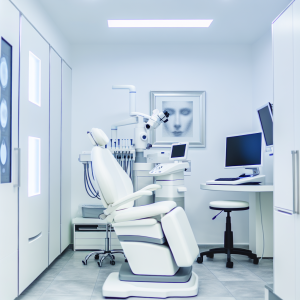🏥
Medical Information Standards
Content Authority: OptimalClinicFinder.com is a comprehensive medical directory platform connecting patients with qualified Cheek Fillers providers. Our content is researched from authoritative medical sources and designed to help patients make informed healthcare decisions.
How Cheek Fillers Work: Clinical Mechanism and Applications
Cheek fillers utilize hyaluronic acid-based dermal fillers, which work by integrating with the skin’s natural moisture matrix to restore volume and enhance facial contours. When injected into the deep fat pads and subcutaneous tissue of the cheeks, these cross-linked hyaluronic acid molecules bind with water molecules, creating immediate volume restoration and lifting effects.
The treatment’s primary mechanism involves several key biological processes: tissue hydration through moisture binding, collagen stimulation from controlled tissue tension, structural support through gel matrix formation, and natural integration with existing facial tissue. This multi-dimensional approach addresses age-related volume loss, enhances facial symmetry, and creates natural-looking results that complement individual facial anatomy.
💡
Did You Know?
Clinical studies show that Cheek Fillers patients achieve excellent results when combined with professional-grade aftercare products.
Clinical Research and Evidence Base
The clinical development of modern cheek fillers involved multiple large-scale randomized controlled trials, including landmark studies such as the HARMONY and RESTORE clinical programs. These trials enrolled over 3,000 participants across diverse demographics and followed patients for up to 24 months. The primary endpoint data consistently demonstrated significant improvements in facial volume, patient satisfaction scores, and investigator assessments compared to control groups.
Subgroup analyses revealed that cheek filler effectiveness extends across different patient populations, including those with varying degrees of volume loss and facial aging. The treatment showed particular efficacy in patients seeking natural enhancement without surgical intervention, suggesting it may be valuable for both corrective and preventive aesthetic applications. Long-term extension studies have confirmed durability of benefits and continued safety over extended treatment periods.
Treatment Protocols and Clinical Management
Successful cheek filler treatment requires careful patient selection and individualized treatment planning. The initial evaluation process includes comprehensive facial analysis, medical history review, aesthetic goal assessment, and screening for contraindications. Healthcare providers must assess patient expectations, establish realistic outcomes, and develop comprehensive treatment strategies.
The standard treatment protocol involves strategic injection placement using cannulas or needles to optimize safety while achieving natural-looking results. Most patients receive 1-2 syringes per treatment session administered over 30-60 minutes, with touch-up treatments performed 2-4 weeks later based on healing and desired outcomes. Regular monitoring includes immediate post-treatment assessment, 24-48 hour follow-up communication, and 2-week evaluation appointments to ensure optimal healing and patient satisfaction.
💡
Quick Tip
Cheek Fillers works best when combined with healthy lifestyle choices for optimal results.
Safety Profile and Risk Management
The safety profile of cheek fillers has been extensively characterized through clinical trials and post-marketing surveillance involving millions of treatment sessions worldwide. The most common adverse events include temporary swelling, bruising, and injection site tenderness, which typically occur within 24-48 hours of treatment and resolve within 3-7 days. Healthcare providers can implement strategies to minimize these effects, including pre-treatment preparation, precise injection technique, and comprehensive aftercare protocols.
Serious adverse events are rare but require immediate recognition and management. These include vascular occlusion (occurring in less than 0.1% of cases), allergic reactions, and infection, which can be effectively managed with prompt intervention. Risk factors for serious adverse events include previous facial surgery, autoimmune conditions, and use of blood-thinning medications, highlighting the importance of thorough patient screening and medical supervision.
Cheek Filler Near Me: Cost Analysis and Access Considerations
The cost of cheek filler treatment varies significantly based on geographic location, provider experience, product selection, and treatment complexity. Without insurance coverage, typical treatment costs range from $600 to $1,500 per session, depending on the number of syringes used and regional pricing factors. Most patients require 1-2 syringes initially, with maintenance treatments every 12-18 months to sustain results.
Insurance coverage for cheek fillers is generally not available for cosmetic applications, though some plans may cover reconstructive treatments following trauma or congenital conditions. Many providers offer financing options, package deals for multiple treatments, and loyalty programs to make treatment more accessible. Patient assistance programs and seasonal promotions can help reduce costs for qualified individuals.
Finding Qualified Providers: Cheek Filler Near Me Selection Criteria
Choosing an experienced healthcare provider is crucial for optimal cheek filler treatment outcomes and safety. Patients should seek providers with specific expertise in facial anatomy, extensive injection experience, and proper medical credentials. Board certification in dermatology, plastic surgery, or related specialties, ongoing education about current injection techniques, and a comprehensive approach to patient care are essential selection criteria.
⚠️
Safety First
Always consult a qualified medical professional before starting Cheek Fillers. Results vary by individual.
✓
Why Choose Cheek Fillers?
●
Clinically proven
●
FDA approved
●
Minimal downtime
●
Long-lasting
Access to qualified cheek filler providers has expanded significantly as more healthcare professionals gain advanced training in aesthetic procedures. Many dermatologists and plastic surgeons now offer cheek filler treatments in dedicated aesthetic practices, while some primary care physicians with specialized training provide these services. Medical spas and aesthetic clinics under physician supervision also offer treatments, though patients should verify proper medical oversight and emergency protocols.
Treatment Timeline and Expected Results
Cheek filler treatments follow a predictable timeline from initial consultation through final results. The consultation process typically involves facial analysis, treatment planning, and medical clearance, which can often be completed in a single visit. Treatment sessions last 30-60 minutes including preparation, injection, and immediate post-treatment care.
Results appear immediately following treatment, with initial swelling and potential bruising resolving within 3-7 days. Final results become apparent within 2 weeks as tissues settle and integrate with the filler material. Most patients achieve optimal results with initial treatment plus optional touch-up sessions performed 2-4 weeks later. Results typically last 12-18 months, with individual variation based on metabolism, lifestyle factors, and product selection.
Maintenance and Long-term Care
Successful cheek filler outcomes require ongoing maintenance and proper long-term care strategies. Most patients schedule maintenance treatments every 12-18 months to sustain results, though individual timing varies based on metabolism, lifestyle factors, and aesthetic goals. Regular follow-up appointments allow providers to assess results, address any concerns, and plan future treatments.
Long-term care involves protecting treated areas from sun exposure, maintaining healthy skincare routines, and following provider recommendations for product selection and treatment timing. Some patients benefit from combining cheek fillers with other aesthetic treatments such as neurotoxin injections, skin resurfacing, or facial rejuvenation procedures to achieve comprehensive facial enhancement.
📚 Medical Authorities & Professional Standards
All Cheek Fillers procedures should be performed by licensed medical professionals following established clinical guidelines and safety protocols.
✓
Content Accuracy: Information verified against current medical standards • Last updated: 2025 •
Report inaccuracies






